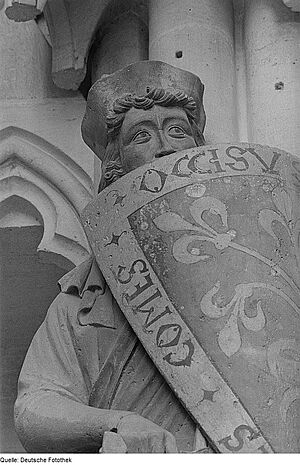Thietmar, Margrave of Meissen facts for kids
Quick facts for kids
Thietmar
|
|
|---|---|
| Margrave of Meissen | |

Donor portrait in Naumburg Cathedral
|
|
| Reign | 976–979 |
| Born | c. 945 |
| Died | 3 August 979 |
| Buried | Nienburg Abbey |
| Spouse(s) | Suanhilde of Billung |
| Issue | Gero II, Margrave of the Saxon Ostmark |
| Father | Christian of Thuringia |
| Mother | Hidda of Merseburg |
Thietmar (II) (born around 945, died August 3, 979) was an important leader known as the Margrave of Meissen. He held this position from about 976 until he passed away.
Contents
Thietmar's Early Life and Family
Thietmar was the oldest of three brothers. Their father was Christian, a count in the Saxon Eastern March. Their mother was Hidda, who was the sister of a famous leader named Gero the Great.
Thietmar's brothers were also important figures. One was Archbishop Gero of Cologne. The other was Margrave Odo of the Saxon Ostmark.
Strong Family Ties
Thietmar made his family even stronger by marrying Swanehilde. She was the daughter of Hermann Billung, a powerful leader who acted as the Duke of Saxony. Swanehilde passed away in 1014.
Thietmar and Swanehilde had one son together. His name was Gero II. Later, in 993, Gero II would take over his uncle Odo's role as Margrave of the Saxon Eastern March.
Thietmar Becomes a Leader
Thietmar first became known in 951. He took over from his father as margrave in an area called Serimunt. A Gau was like a region or district.
Between 951 and 978, Thietmar was also a count in the Saxon Schwabengau. In 965, his uncle Gero the Great died. Thietmar inherited a large part of Gero's huge territory, which was known as the Marca Geronis.
Before 976, another margrave named Wigbert died. After this, Emperor Otto II gave Thietmar the important area known as the Margraviate of Meissen.
Building a Monastery
On August 29, 970, Margrave Thietmar and his brother Gero of Cologne started a special project. They founded a monastery called Thankmarsfelde. A monastery is a place where monks live and worship.
Between 971 and 975, this monastery became a royal monastery, meaning it was supported by the king. In 975, it was moved to Nienburg. This new location was where the Saale and Bode rivers meet.
In the years that followed, Thietmar and Gero gave more land to the monastery. Thietmar was also buried there after he died.
After Thietmar's death, a count from Schwabengau named Rikdag took over his position. Thietmar's widow, Swanehilde, later married Rikdag's successor, Margrave Eckard I of Meissen.

